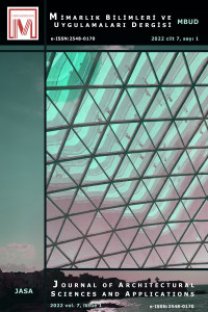Computer Vision Metodlarıyla Çeşitli Mimari Üslupların Tahmin Edilmesi
Computer vision, nesne algılama, YOLO, mimari üslup
Predicting Various Architectural Styles Using Computer Vision Methods
Computer vision, object detection, YOLO, architectural style,
___
- Boesch, G. (2023a, January 20). What is Computer Vision? The Complete Tech Guide for 2023 - viso.ai. Viso.Ai. http://viso.ai/computer-vision/what-is-computer-vision/.
- Boesch, G. (2023b, February 21). Object Detection in 2023: The Definitive Guide - viso.ai. Viso.Ai. http://viso.ai/deep-learning/object-detection/
- Contributors to Wikimedia projects. (2001a, August 8). Casa Batlló - Wikipedia. Retrieved September 25, 2023, from Wikipedia, the free encyclopedia website: https://en.wikipedia.org/wiki/Casa_Batllo
- Contributors to Wikimedia projects. (2001b, October 26). Architecture - Wikipedia. Retrieved March 2, 2023, from Wikipedia, the free encyclopedia website: http://en.wikipedia.org/wiki/Architecture
- Contributors to Wikimedia projects. (2002a, May 24). Palace of Versailles - Wikipedia. Retrieved September 25, 2023, from Wikipedia, the free encyclopedia website: https://en.wikipedia.org/wiki/Palace_of_Versailles
- Contributors to Wikimedia projects. (2002b, July 15). Notre-Dame de Paris - Wikipedia. Retrieved September 25, 2023, from Wikipedia, the free encyclopedia website: https://en.wikipedia.org/wiki/Notre-Dame_de_Paris
- Contributors to Wikimedia projects. (2003a, May 6). Milan Cathedral - Wikipedia. Retrieved September 25, 2023, from Wikipedia, the free encyclopedia website: https://en.wikipedia.org/wiki/Milan_Cathedral
- Contributors to Wikimedia projects. (2003b, October 6). Trevi Fountain - Wikipedia. Retrieved September 25, 2023, from Wikipedia, the free encyclopedia website: https://en.wikipedia.org/wiki/Trevi_Fountain
- Contributors to Wikimedia projects. (2006, May 17). Palladian villas of the Veneto - Wikipedia. Retrieved September 25, 2023, from Wikipedia, the free encyclopedia website: https://en.wikipedia.org/wiki/Palladian_villas_of_the_Veneto
- Contributors to Wikimedia projects. (2008, February 18). Object detection - Wikipedia. Retrieved March 10, 2023, from Wikipedia, the free encyclopedia website: http://en.wikipedia.org/wiki/Object_detection
- Dwyer, B. (2020, May 8). When Should I Auto-Orient My Images? Roboflow Blog; Roboflow Blog. http://blog.roboflow.com/exif-auto-orientation/
- Efe, M. O. & Kaynak, O. (1999). A comparative study of neural network structures in identification of nonlinear systems. Mechatronics, 3, 287–300. https://doi.org/10.1016/s0957-4158(98)00047-6
- Elmas, Ç. (2018). Yapay Zeka Uygulamaları (4th ed.). Seçkin.
- Handuo. (2018, August 20). You only look once (YOLO) -- (1) | Zhang Handuo’s Site. Zhang Handuo’s Site; Zhang Handuo’s Site. http://zhanghanduo.github.io/post/yolo1/.
- Hosni, Y. (2022, October 14). Overview of Computer Vision Tasks & Applications. Pub.Towardsai.Net; Towards AI. https://pub.towardsai.net/overview-of-the-computer-vision-tasks-applications-647f63e66e9f
- Jocher, G. & Waxmann, S. (2023, May 1). YOLOv8 - Ultralytics YOLOv8 Docs. Ultralytics. https://docs.ultralytics.com/models/yolov8/
- Jocher, G., Waxmann, S. & Chaurasia, A. (2023, March 12). Ultralytics YOLOv8 Modes. Ultralytics YOLOv8 Docs. http://docs.ultralytics.com/#yolo-a-brief-history.
- Kasper-Eulaers, M., Hahn, N., Berger, S., Sebulonsen, T., Myrland, Ø. & Kummervold, P. E. (2021). Short communication: detecting heavy goods vehicles in rest areas in winter conditions using YOLOv5. Algorithms, 4, 114. https://doi.org/10.3390/a14040114
- Kristo, M., Ivasic-Kos, M. & Pobar, M. (2020). Thermal Object Detection in Difficult Weather Conditions Using YOLO. IEEE Access, 125459–125476. https://doi.org/10.1109/access.2020.3007481
- Özel, M. A., Baysal, S. S. & Şahin, M. (2021). Derin öğrenme algoritması (YOLO) ile dinamik test süresince süspansiyon parçalarında çatlak tespiti. Avrupa Bilim ve Teknoloji Dergisi, Ejosat, 1–5. https://doi.org/10.31590/ejosat.952798
- Öztürkoğlu, M. (2023a, April 25). Architectural Buildings3 Computer Vision Project. Roboflow. http://app.roboflow.com/meryem-dgz60/architecturalbuildings3/1
- Öztürkoğlu, M. (2023b, April 30). Estimating Various Architectural Styles with Computer Vision Methods. Google Colab. https://colab.research.google.com/drive/1ldJ4P2tMJhCaK7j7LxO-ct3UygW9ERCq?usp=sharing
- Öztürkoğlu, M. (2023c, May 9). Before Train_Estimating Various Architectural Styles with Computer Vision Methods. Youtube.Com; YouTube. https://www.youtube.com/watch?v=bgctNx_1luE
- Öztürkoğlu, M. (2023d, May 10). Estimating Various Architectural Styles with Computer Vision Methods. Youtube.Com; YouTube. https://www.youtube.com/watch?v=CC7fakCsCSM
- Rath, S. (2023, January 10). YOLOv8 Ultralytics: State-of-the-Art YOLO Models. LearnOpenCV. http://learnopencv.com/ultralytics-yolov8/.
- Redmon, J., Divvala, S., Girshick, R. & Farhadi, A. (2016). You Only Look Once: Unified, Real-Time Object Detection. 2016 IEEE Conference on Computer Vision and Pattern Recognition (CVPR). https://doi.org/10.1109/cvpr.2016.91
- Roboflow. (2020, January). Roboflow. https://roboflow.com
- Sager, C., Janiesch, C. & Zschech, P. (2021). A survey of image labelling for computer vision applications. Journal of Business Analytics,2,91–110.https://doi.org/10.1080/2573234x.2021.1908861
- Simplilearn. (2022, August 30). What is Epoch in Machine Learning? | Simplilearn. Retrieved September 25, 2023, from Simplilearn.com website: https://www.simplilearn.com/tutorials/machine-learning-tutorial/what-is- epoch-in-machine-learning?tag=epoch
- Su, C. (2008, April 5). Introduction to Computer Vision. Carleton.Ca; National Research Council Canada. https://people.scs.carleton.ca/~c_shu/Courses/comp4900d/notes/lect1_intro.pdf
- Szeliski, R. (2010). Computer Vision (1st ed., p. 5). Springer.
- Terven, J. & Cordova-Esparza, Diana-Margarita. (2023). A Comprehensive Review of YOLO: From YOLOv1 to YOLOv8 and Beyond.
- Trucco, E. & Verri, A. (1998). Introductory Techniques for 3-D Computer Vision. Prentice Hall.
- Vitruvius. (1999). Vitruvius: “Ten Books on Architecture” (I. D. Rowland, Ed.; T. N. Howe, Trans.). Cambridge University Press.
- Williams, K. (2021, July 5). How to Build a Computer Vision Model. Medium. http://medium.com/mlearning- ai/what-does-end-to-end-really-mean-f634b193ba00.
- Wwymak. (n.d.). Architecture dataset | Kaggle. Kaggle: Your Machine Learning and Data Science Community. Retrieved June 28, 2023, from http://www.kaggle.com/datasets/wwymak/architecture-dataset
- Xu, Z., Tao, D., Zhang, Y., Wu, J., & Tsoi, A. C. (2014). Architectural Style Classification Using Multinomial Latent Logistic Regression. In Computer Vision – ECCV 2014 (pp. 600–615). Springer International Publishing. http://dx.doi.org/10.1007/978-3-319-10590-1_39
- Yıldız, M. A., Ertosun Yıldız, M. & Beyhan, F. (2023). Developing dynamic and flexible façade design with fractal geometry. Journal of Architectural Sciences and Applications, 8 (1), 1-14. DOI: 10.30785/mbud.1230875.
- Yayın Aralığı: 2
- Başlangıç: 2016
- Yayıncı: Atila GÜL
Yaşlı Kullanıcılar İçin Yerinde Yaşlanması Destekleyen Konutlarda İç Mekân
Aslı İlayda KOÇAK, Murat AKTEN
Göreme Saklı Kilise Özelinde Kaya Oyma Kiliselerinde Koruma Girişimleri/Değerlendirmeleri
Hatıra Peyzajlarının Evrimi: Gelibolu Tarihi Alanı’ndaki Anma Mekanlarının Analizi
Ampirik Termal Konfor Değerlendirme Yöntemlerinin Bulanık Mantıkla Zenginleştirilmesi
Tasarım ve Malzeme İlişkisinin Sürdürülebilirlik Bakımından Çok Boyutlu İncelemesi
Mimari Tasarımda “Yeniden Kullanım” Üzerine Bir Stüdyo Çalışması
İrem BEKAR, Ertuğrul Saffet LÜLECİ, Mert ÇAKIR
Kentsel Dayanıklılığı Sağlamak için Yöresel Mimarlığı Keşfetmek: Mimarlık Eğitiminde bir Deneme
Rengin BECEREN ÖZTÜRK, Arzu CAHANTİMUR
Cephelerde Müdahale ve Hasarların İncelenmesi: Selamsız Ucuz Evler Örneği İstanbul, Türkiye
Hatice Yasemin ÇAKIR, N. Volkan GÜR
Okul Bahçelerinde Açık Hava Sınıfı Tasarımı Üzerine Bir Araştırma
